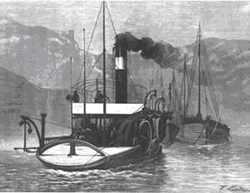The Integration of Infrastructures in Europe before the Great War and after the Second World War in comparison
Subproject: Integration of the inland navigation

Rheintauer ("Hex") mit seitlich
beweglichen Leitrollen - Seilschleppschifffahrt auf dem
Rhein, 1869.
Source: http://www.wsd-west.wsv.de/...
This subproject deals with the integration of inland navigation on the Rhine that is a prominent representative for inland navigation in Europe.
Being one of the longest rivers in Europe, the Rhine runs through several countries in his course. Today, these are Switzerland, Liechtenstein, Austria, France, Germany and the Netherlands. The busiest waterway in Western Europe has always been of huge importance for the economy and trade. 200 years ago, inland navigation was the easiest and most efficient method to transport goods over long distances. From the 1840 onwards, it had to cope with the competing railways and as from the 1940s with aircrafts, as well. Today, it is experiencing a renaissance. Furthermore, questions concerning the exploitation of the river for water power and environmental protection have gained importance over the years.
Since the Rhine’s navigable course runs through various states international agreements for the smooth transport of goods had to be agreed very early. Every state had its own rules regarding the permission for navigation on the Rhine or tax levy etc. Riparian states, tradesmen, energy companies and environmentalists all had an interest in the Rhine, however, not always the same. Negotiations took place between two or more states, institutions or within international organisations.
The Central Commission for Navigation on the Rhine is the oldest international organisation that still exists today. It was founded by the Congress of Vienna in 1815. Diplomatic delegates of the riparian states met in the Central Commission and discussed rules for the Rhine’s entire navigable course. Tariffs and duties, lighting and other safety regulations or boat master’s licences were only some of the areas the Central Commission occupied itself with. In the years following the end of WWII, several international organisations were founded that dealt with inland navigation. These organisations, such as the European Conference of Ministers of Transport or the European Economic Community, competed with each other for the competence to set up rules for the navigation on the Rhine, insurance and social security of the boatmen or environmental protection. Shipping companies etc. tried to influence regulations via non-governmental organisations.
This subproject wants to take a closer look at the way negotiations took place and seeks to analyse how economic and political agreements, for instance, on tariffs, law and technology were achieved.
